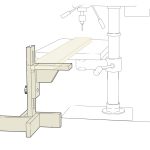We may receive a commission when you use our affiliate links. However, this does not impact our recommendations.
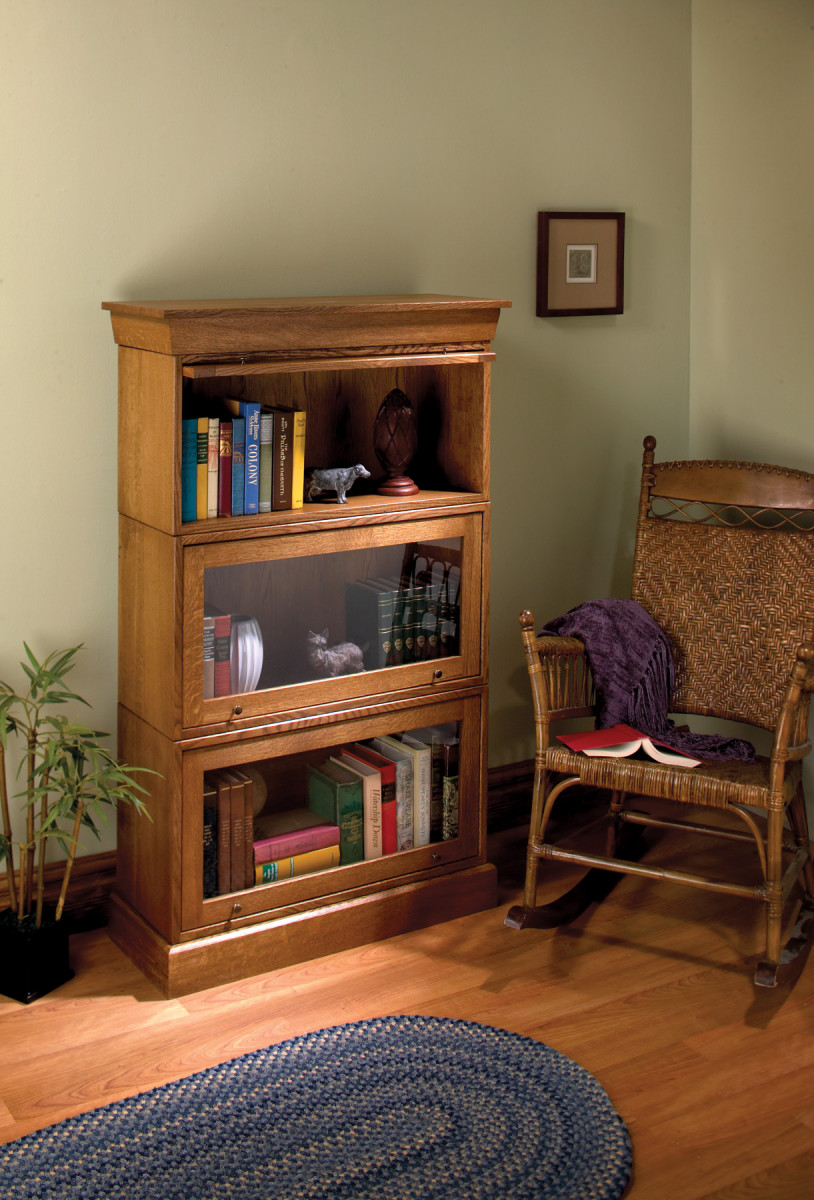
We redesigned this classic with techniques so simple even a novice can build it!
Project #1918 • Skill Level: Beginner • Time: 3 days
Almost everyone likes the look of barrister bookcases. But what makes them so appealing? I think there are a number of characteristics that make the barrister design popular and enduring.
First is that the individual units of the case stack together. And because they are separate units, they can be arranged in any desired height configuration to fit any area of your home or office.
Second, they are elegant as well as functional. The wood-framed glass doors, when lowered, protect your books or other valuables from moisture and dust—not to mention those tiny pudding-laced fingers of the little ones. They also allow you to look through the glass for a specific item without the undo stress of operating the doors. In the open position, with the doors raised and slid back into the case, you have easy access to those leather-bound sources of knowledge.
Third, as you will see, we rethought the construction so these cases can be built with the easiest techniques—without sacrificing any classic design elements. These are the easiest barrister bookcases you will ever build.
We decided to build a stack of three units—each identical in construction and design, with one slightly different in height. There are two larger units for over-sized books and special keepsakes, and one that is slightly shorter in height. Those, along with the top and bottom units, add up to the appropriate design for our bookcase needs.
Your set can be created with only one unit, or it could be a stack of five, along with the top and bottom sections. (More than five units is unwieldy and potentially unstable.)
One Panel Chops into Three
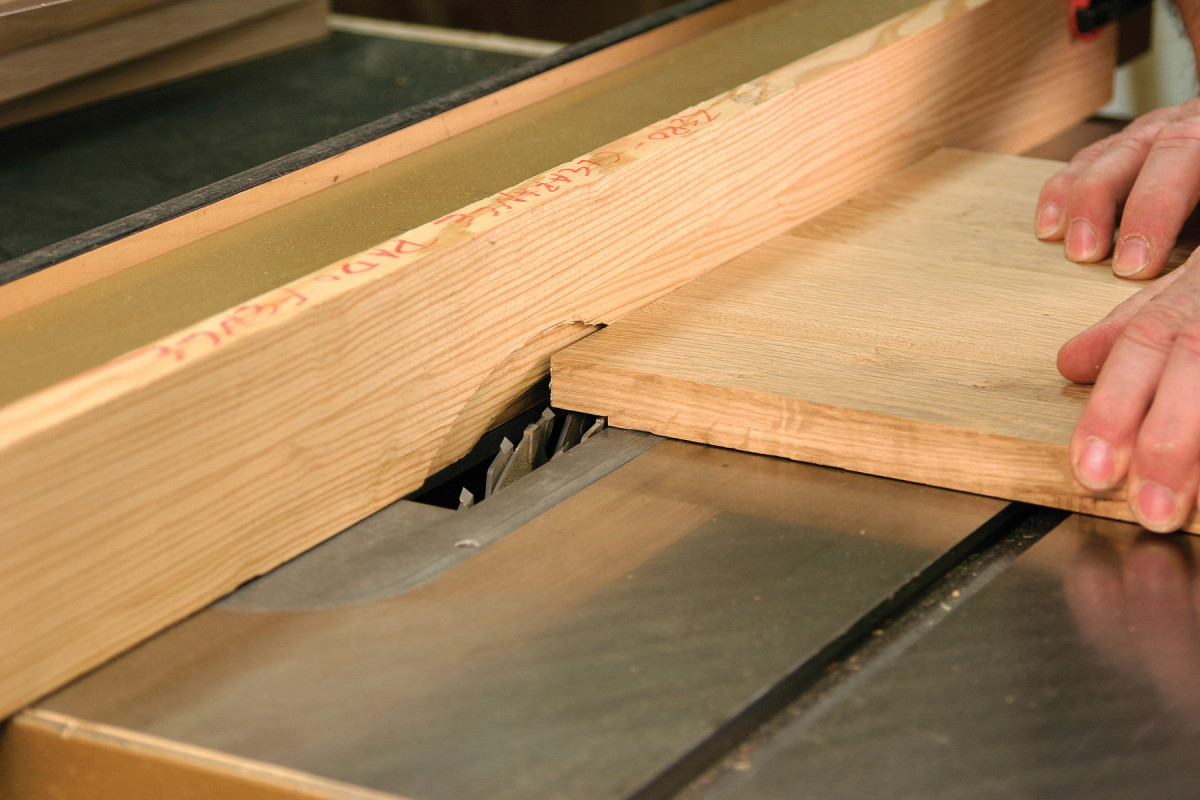
1. Using the widest setting on a dado stack along with a sacrificial fence is the best choice for creating rabbets for these case sides. This will ensure that the cut clears the waste entirely.
We wanted the grain on each case side to be consistent from top to bottom as we stacked our individual units. This is a matter of aesthetics, not a necessity. (I’m sure somewhere during this case’s lifetime, the units will be stacked without regard to the grain.)
What is a necessity, in order to get the units to stack without problems, is to make the width of each unit equal in size. This is best accomplished by starting with one large glued-up panel of the correct width that is then crosscut into the appropriate lengths.
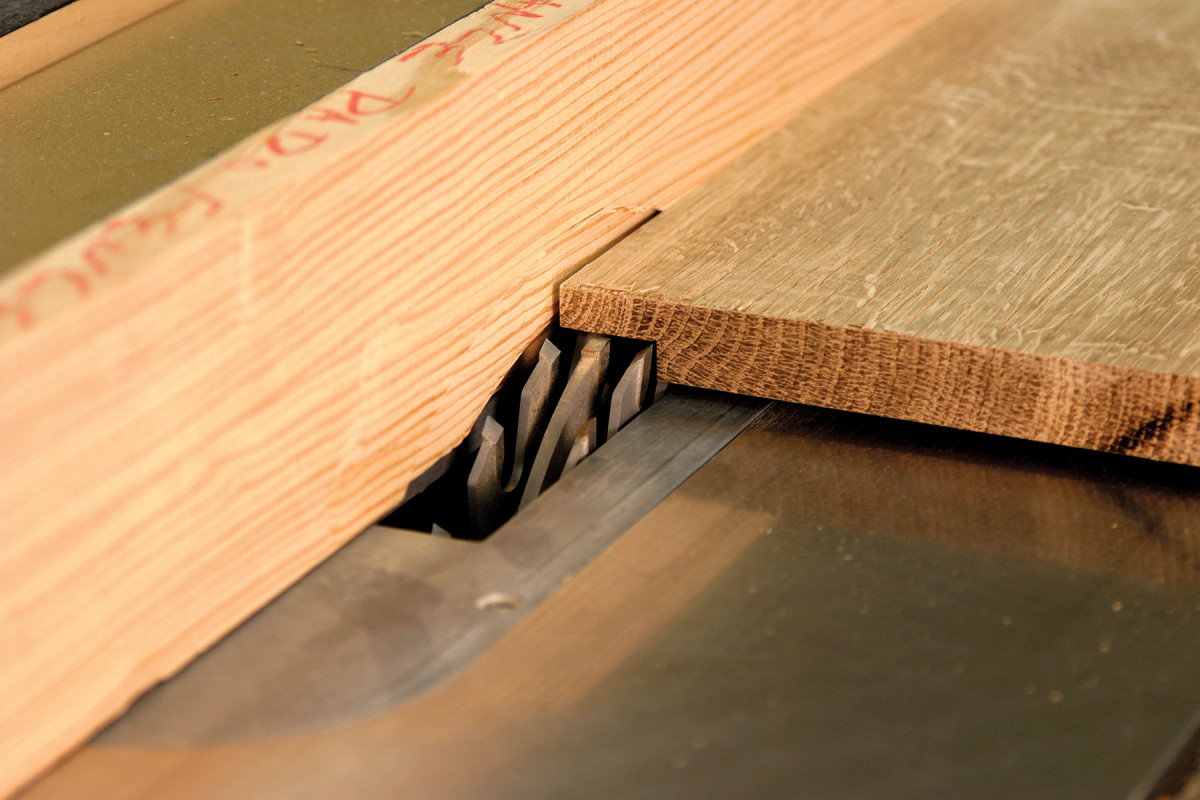
2. Raising the blade height is the only adjustment needed to cut the backboard rabbets. The front edge of this side looks as though it is raised from saw top because of the previous rabbet cut.
Once the sides are milled according to the plan, there are three rabbets that need to be cut in each side panel. One rabbet goes at the top and bottom of each side panel. Those rabbets are for the full-width case bottom and the front and back rails at the top. You also need a rabbet at the back edge of the side panels that will house the backboards. That rabbet hides the backboards when viewing the bookcase from the side.
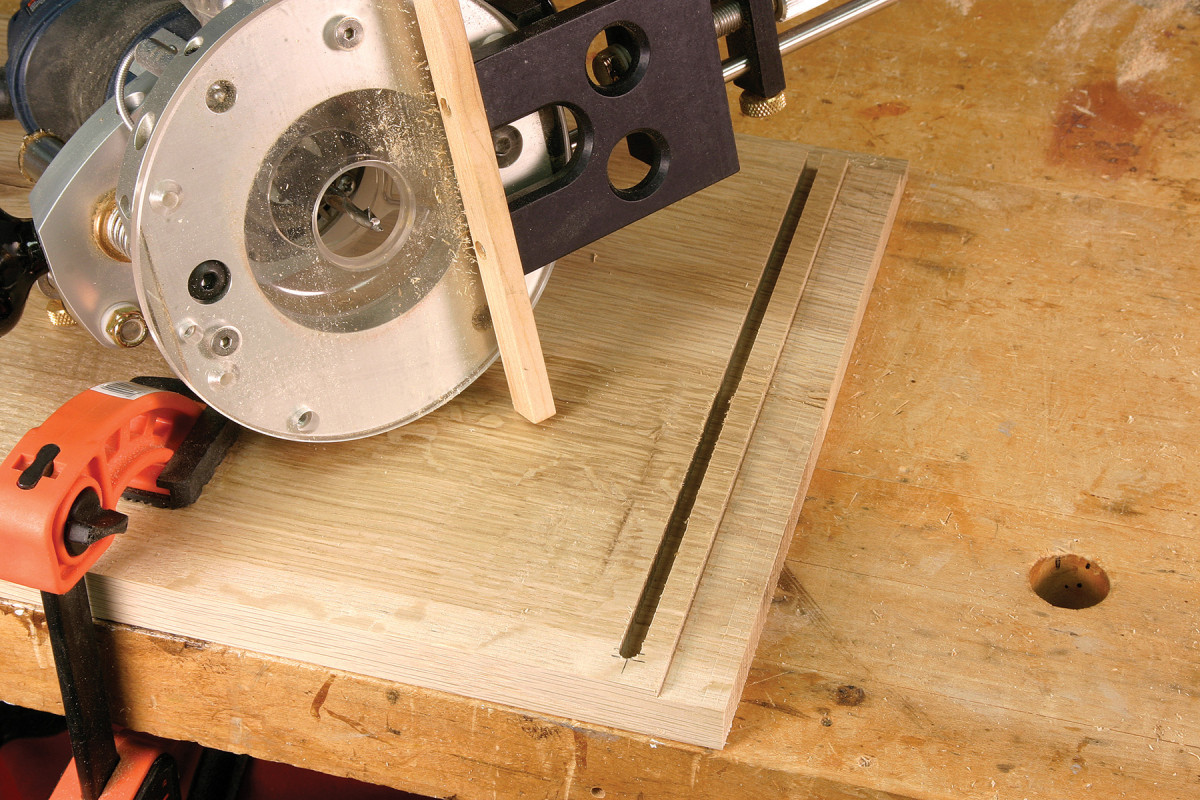
3. Creating the groove for the door pins to ride in is the most exacting step of the process. A plunge router with a guide fence makes it short work. Check the layout before routing.
A dado blade is the best choice for cutting the rabbets. Install a sacrificial fence, set the blade for the widest cut (at least 3/4“) and position the blade below the saw top. Adjust the fence to the blade so that 3/4” of cutting width is exposed and with the blade running, slowly raise the cutter to a height of 1/8“. With this setting, a single pass over the blade will create the 3/4“-wide x 1/8“-deep rabbets at the top and bottom edge of the side panels.
Next, again with the blade moving, raise the height to 7/16“. This is to create the rabbet for the backboards. They fit into a 3/4“-wide x 7/16“-deep rabbet. If you are trying to keep the grain aligned, as we have, you need to determine the front edge of the bookcase prior to crosscutting the individual side panels into smaller sections. Or, choose the best edge of your stock for the front face at this time and cut the backboard rabbets into the opposite edge.
Your Groove is Important
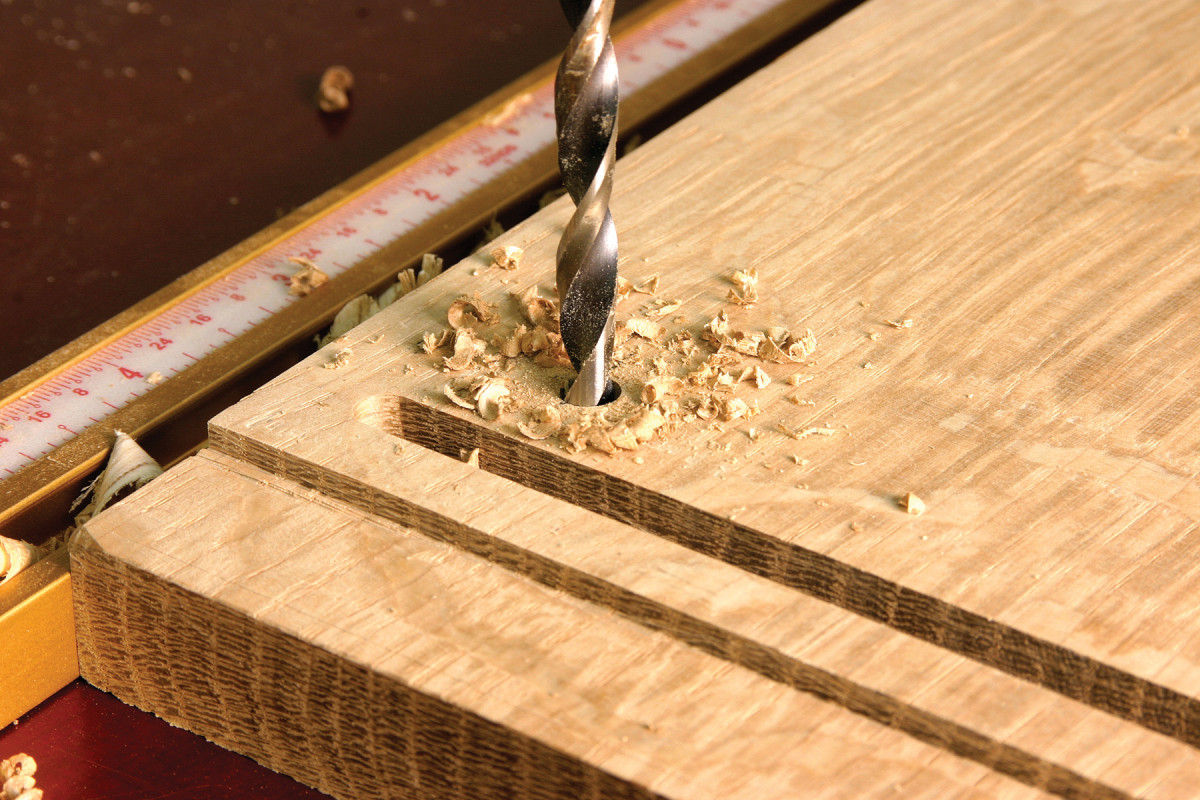
4. There are pin locations at both the top and bottom that act as guides for the doors. Use the drill press for this step—unless you have a very steady hand and good eye.
Creating the groove in which the doors slide is the most difficult task involved in building these bookcases—but all it takes is a plunge router with a guide fence and a 1/4” upcut spiral router bit.
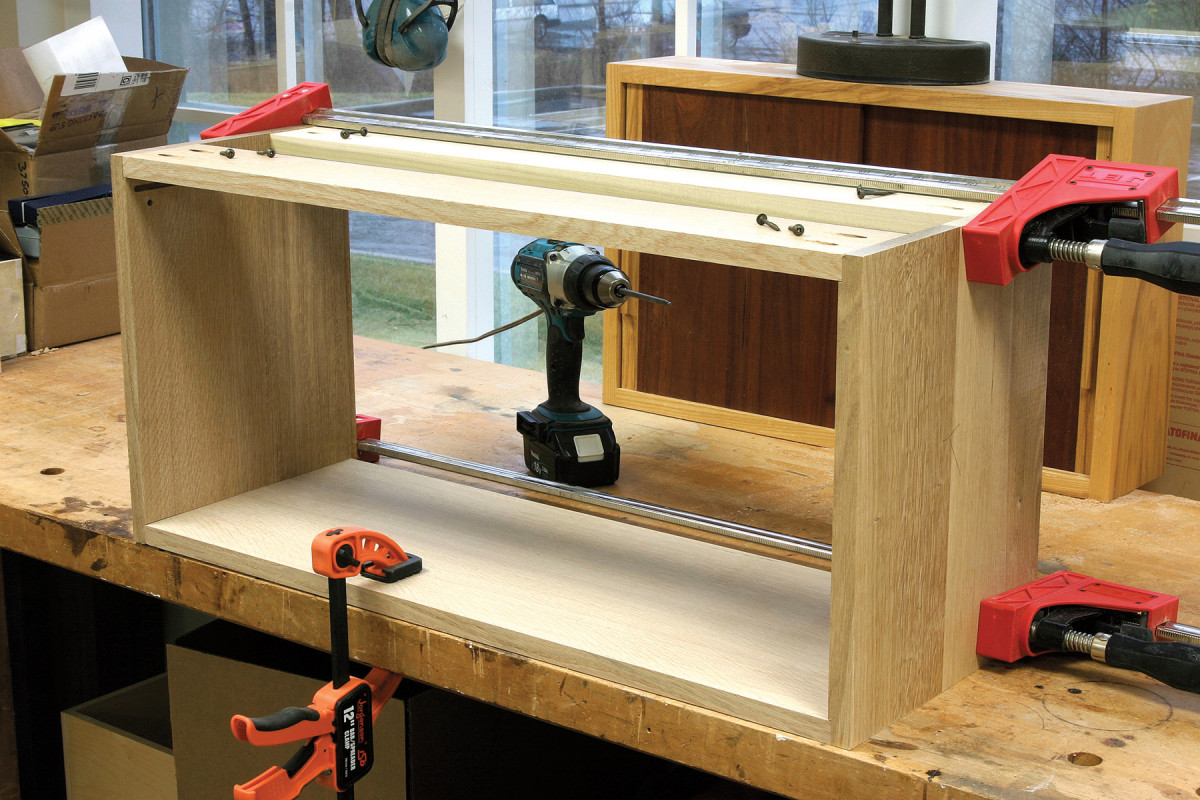
5. Assembling the boxes is a matter of 14 pocket screws. Clamping the box ensures that it will be square. The opening in the top is for the adjoining catch rail on a second unit.
Positioning this groove is the trick. It needs to be located correctly from the top edge of the sides, so the guide fence of the router becomes key. Set the fence so the router bit plunges into the side with 11/8” of material between the top edge and the groove. The 1/4” cut will then be perfectly set for the placement of the centered brass rods in the bookcase doors, and it builds in the necessary 1/8” spacing so the top edge of the door does not bind when opened.
Next, you need to find the starting or stopping point of the cut depending on which side you’re working. On each right-side panel you’ll plunge at the front edge and finish the cut through the backboard rabbet. On the left-side panels you’ll begin coming through that rabbet and complete the cut by stopping at the correct location and removing the bit from the work surface. Attacking the groove this way registers each cut off of the top edge of the side panels and makes the best use of the guide fence.
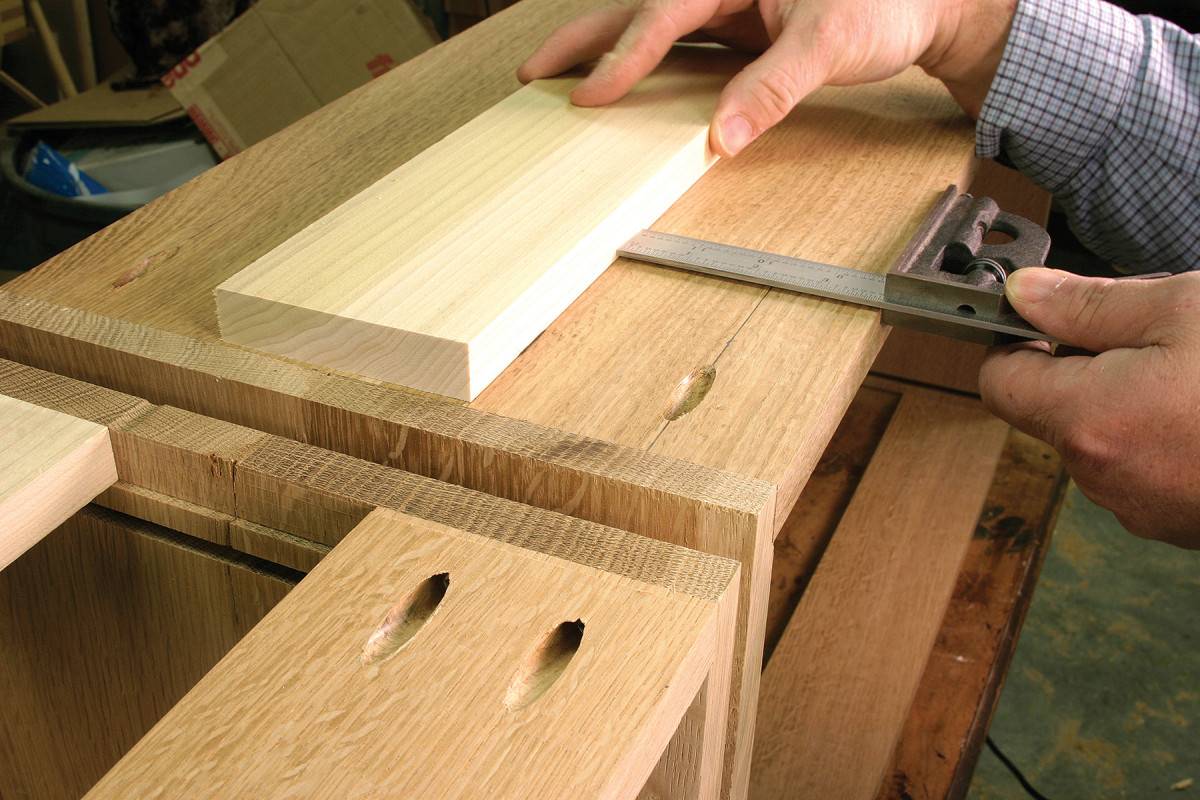
6. The catch rail is fastened to the box bottom. It’s important to properly align the piece to fit the other units.
The location that you need to stop on is 3/8” in from the front edge of the sides to the beginning of the routed groove. Where did this number come from, beside the plan? The 1/4” brass rods that are used to hang the doors are located in the center of the 3/4“-thick doors. The outer 1/4” of door stock along with the design feature of the 1/8” offset of the door to the front edge of the case adds up to that exact location.
With the setup and location locked in, rout the 5/16“-deep grooves into the sides as shown in the picture at right.
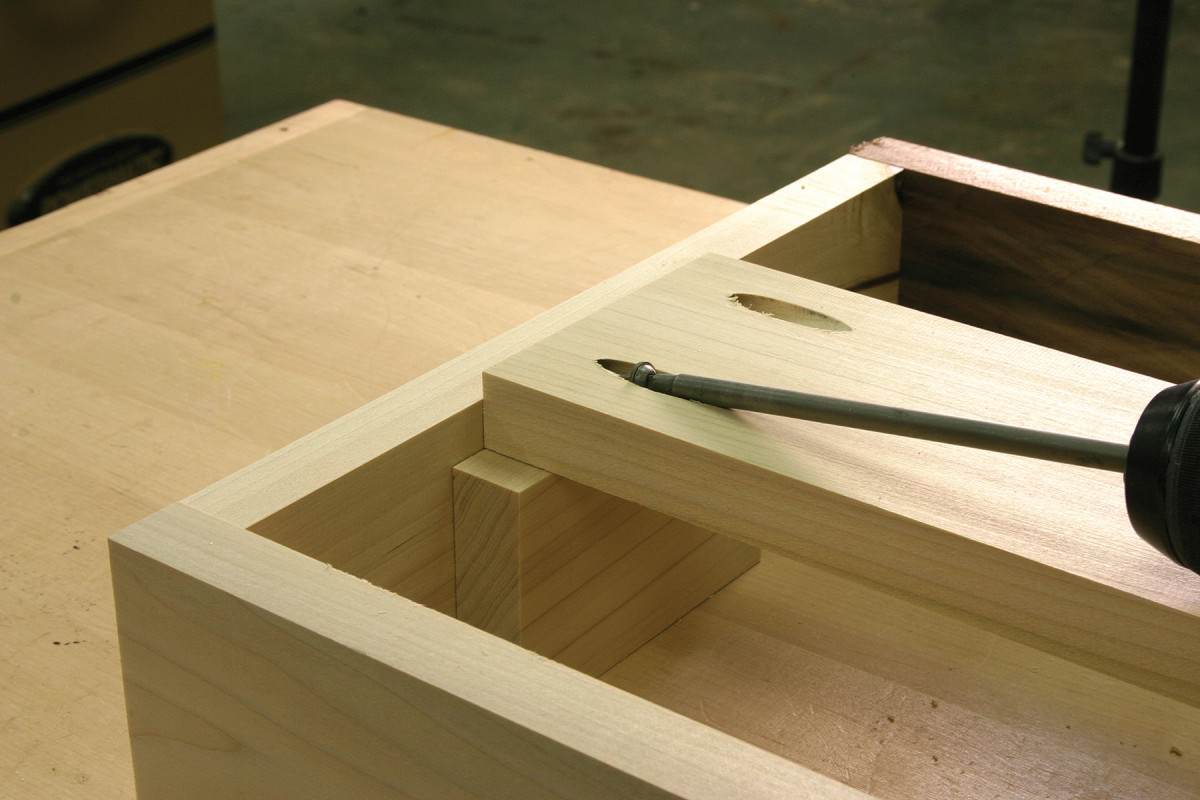
7. The catch rail for the top unit rests inside the end rails. To keep the rail from sliding downward as the screws are installed, rest the piece on a block cut to the correct size.
The doors will be held in position toward the front with two brass rods per side. The top rod is centered 13/4” from the top edge of the side and in 1″ from the front edge. These two rods act as a pivot for the sliding door.
The second rod location is pulled from the bottom edge of the sides and is also set at a measurement of 13/4“. It too is located 1” in from the front edge. This rod placement gives the door something to close against while holding the door parallel to the case front when closed.
Assemble the Box

8. The 3″ rail in the base unit is toward the front while the wider rail is held to the back. Each rail is not only connected to the frame side, it is also attached to the center support.
Mill to size and thickness the material for the top-front rails, rear rails and the catch rails, as well as the bottoms. You can get away with using a secondary wood for the rear and catch rails, as we chose to do, because these pieces will not be seen as you view the bookcase. All pieces connect to the sides with pocket screws.
Cut three pocket-screw holes on the worst face of the bottoms, leaving the best face for the inside of the piece. Position a hole at 11/2” from each edge and one that is centered across the bottoms. The rails used for the top also attach with pocket screws. Place two holes at each end of both rails.
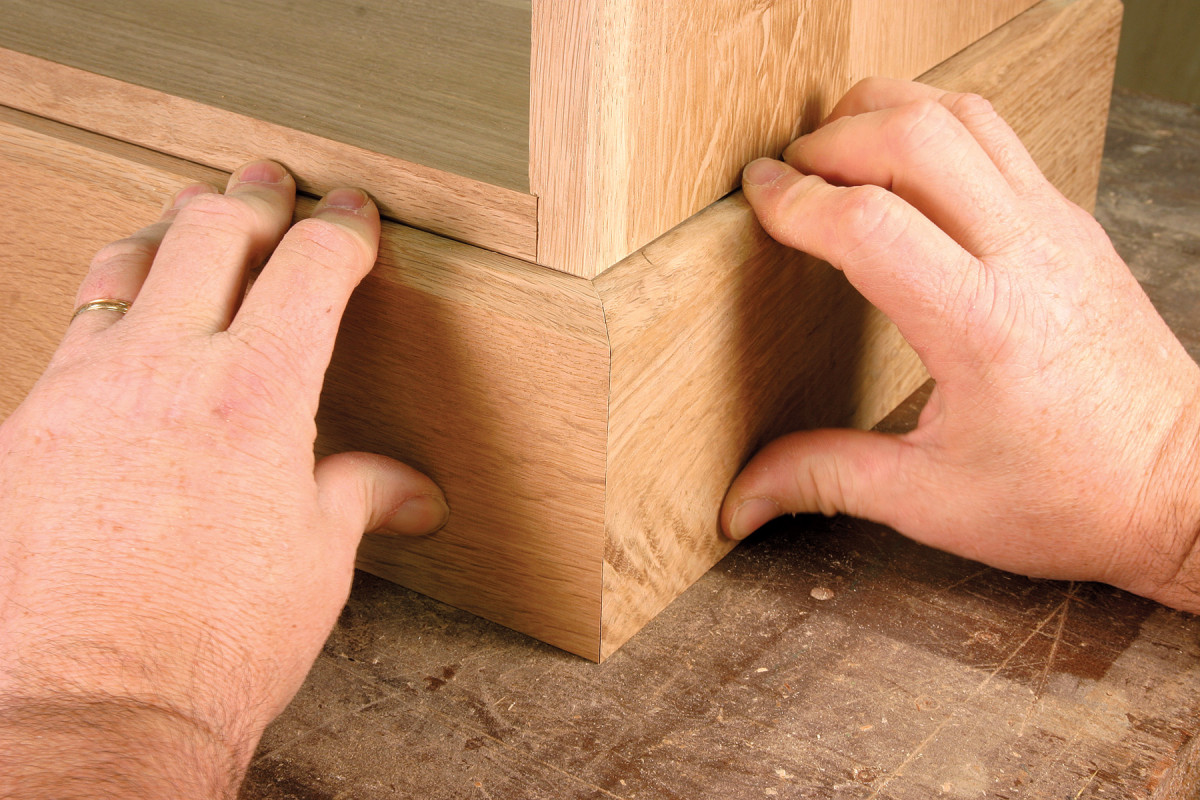
9. The chamfered base moulding is fit to the base frame on three sides. The secondary wood of the frame is hidden when the bookcase is stacked.
Now you are ready to assemble the boxes. Position the bottom on your bench and match the two sides to the bottom, making sure that the bottom fits into the shallow rabbets. Next, slide the top rails in place—the oak at the front and the secondary wood at the rear. These rails fit into the rabbets at the top edge. Add clamps as shown below then attach the rails to the sides with the screws. Flip the box then add the screws to attach the bottom.
With the box set on its top, position and attach the catch rail to the bottom. Align the piece off of the front edge of the unit and center the rail from side to side. Each rail lines up with the inside face of the side, not the edge of the rabbet area. Attach the rails to the bottom with wood screws.
Creating the frames for the top and base units is next. We found that building the frames and then attaching the mouldings was the best way to approach this part of the project. It also allowed us to use secondary wood for these hidden areas.
Each frame starts with the assembly of a box. The end supports receive the pocket-screw holes and are attached to the rails through that connection. Also, while you have the pocket-screw jig out, add a number of holes to the top frame that you’ll use for attaching the top.
With the narrowness of the frames, you should arrange the pieces so the screws are to the outside of the unit. The drill, with the square drive installed, is too large for the inside of the frame. You should also attach the center support, the piece that runs from front to back and is centered along the width of each frame, through the outside with four #8 x 11/4” wood screws.
From this point the construction of the frames differs. In order for the top and base units to fit the design of the bookcase, the top unit must have a catch rail while the base unit receives a front and back flat rail.
The catch rail of the top unit fits between the frame’s side rails, with a 1/4” extending beyond the side rails, and attaches to the center support with two #8 x 11/4” wood screws.
Make sure that the catch rail is aligned to fit into the top rails of any of the bookcase units—they are all consistently positioned, making them interchangeable.
In the base unit the front and rear flat rails are set flush with the top edge of the frame and attached using the pocket-screw method. Remember that the front rail is only 3″ wide, whereas the rear rail is 33/4“. Each of these flat rails also attaches to the center support with #8 x 11/4” wood screws.
The mouldings are next. Mill the material for the crown moulding, the base moulding and the bookcase top to size and thickness. The top edge of the base moulding has a 3/8” chamfer. Cut the edge with a router equipped with a chamfering bit, then fit the pieces to the base. Because there is a solid frame backing the mouldings you can nail the pieces in place with brads. Add a small bead of glue at the mitered corners as you assemble the mouldings for added strength.
Barrister Bookcase Cut List

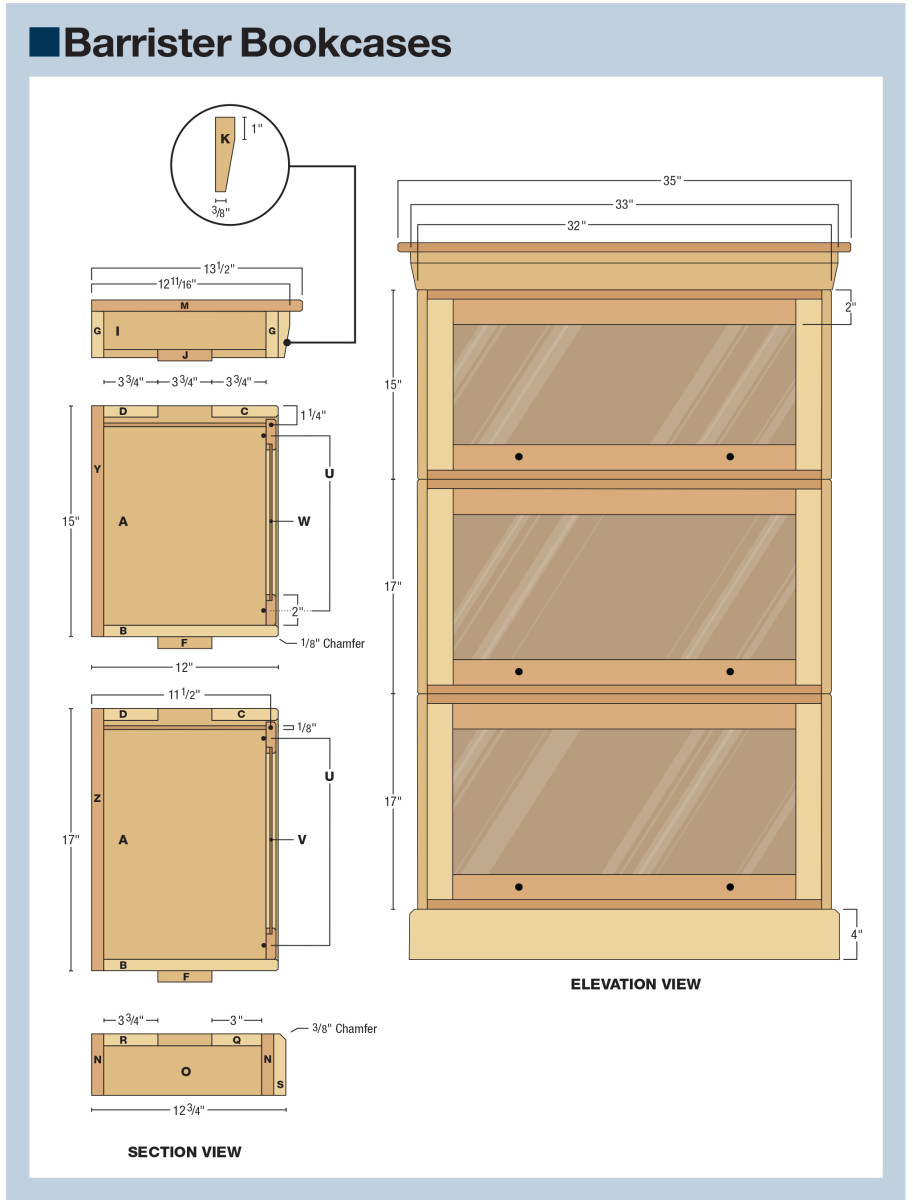
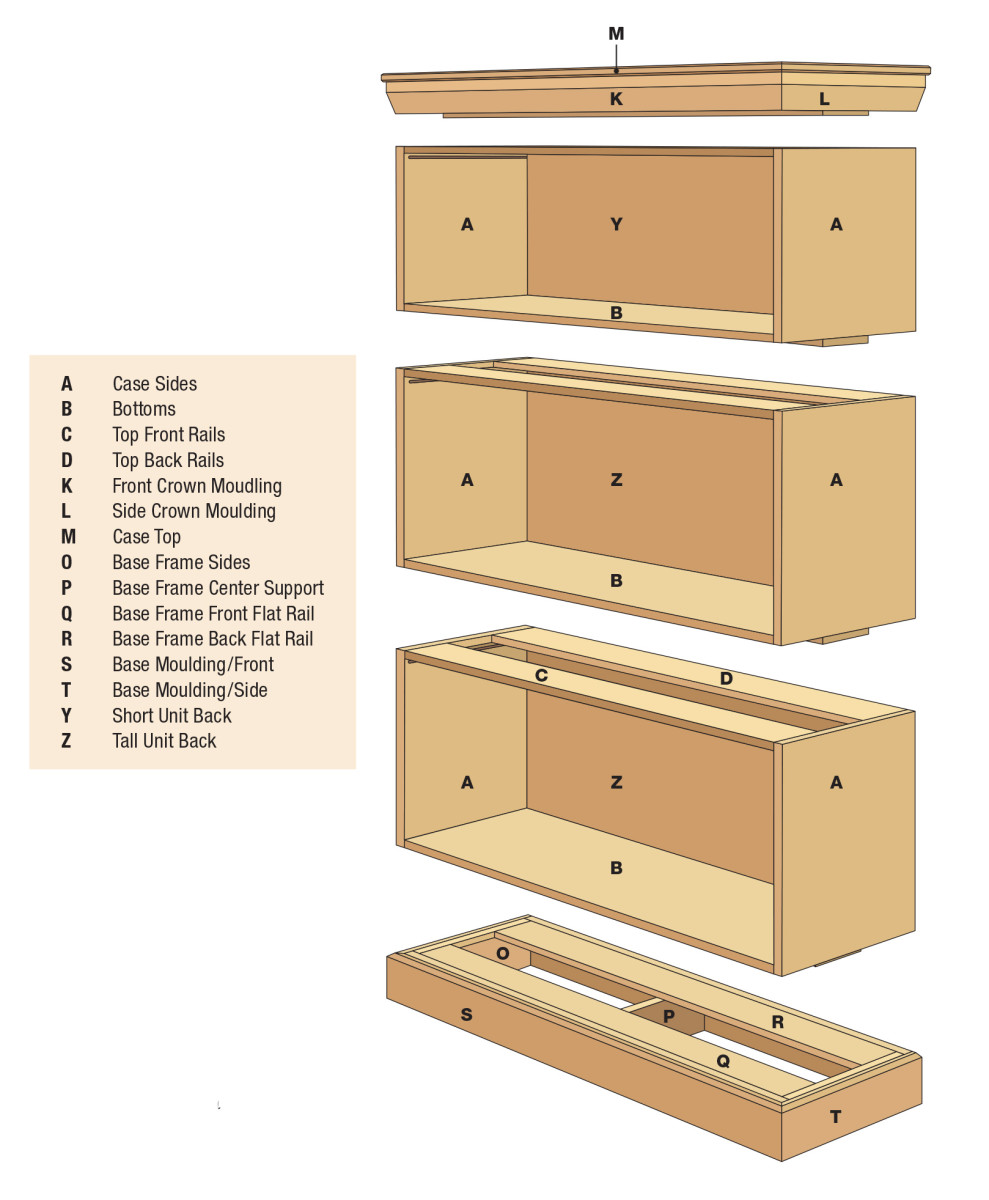 Make the Crown Moulding
Make the Crown Moulding
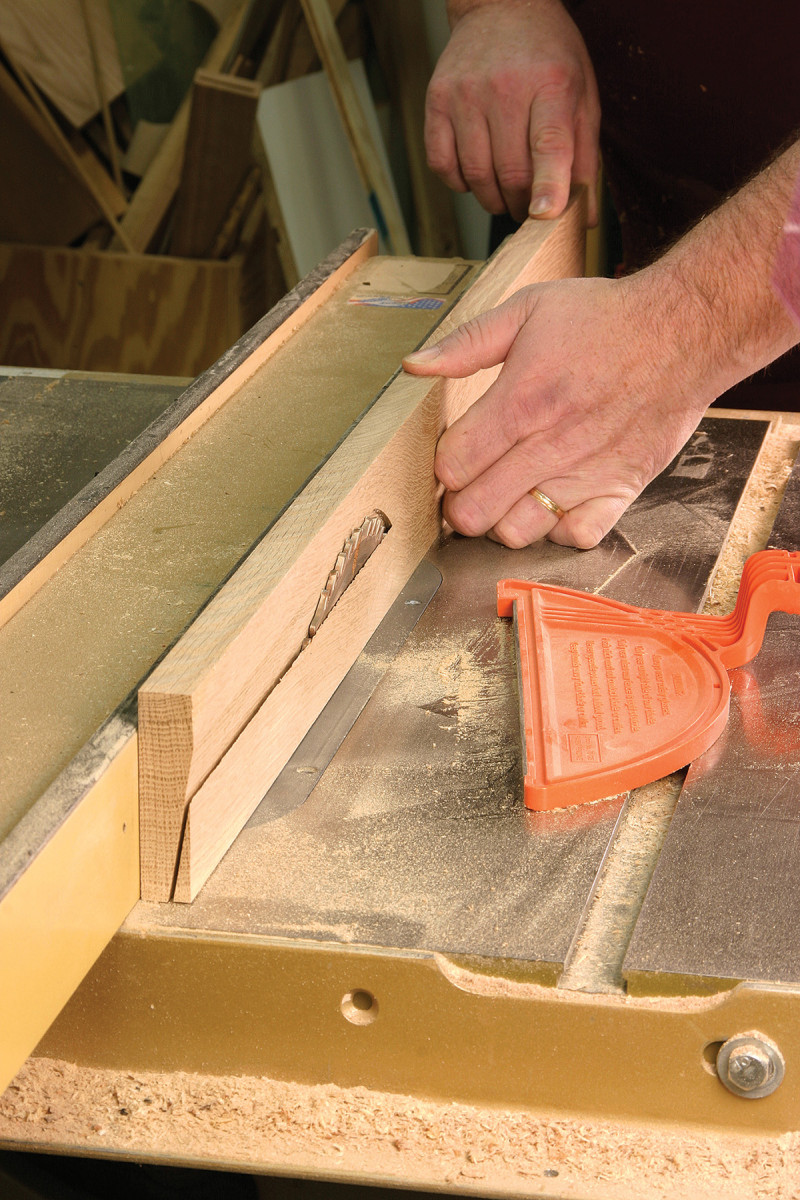
10. The cutting of the crown moulding can leave saw kerf indications and burn marks. A quick run over the jointer knives works best to clean the face.
The crown moulding is a bit more complex than the base moulding. It begins with a cut at the table saw. Tip the blade to 10° and position the fence so that the blade exits the stock about 1″ down from the top. This will leave about 3/8” of material at the bottom edge of the stock. This setting will need to be fine-tuned at your saw. Run the cut for both pieces of stock—one for the front and one piece that is crosscut into the two ends.
I elected to make a pass over the jointer to clean up the saw marks on my mouldings. Set a light depth of cut and be sure to use push sticks. If you choose not to use the jointer you can sand the moulding face smooth. Once the piece is cleaned and sanded it can be attached to the top frame.
I work counter-clockwise around the unit to get an accurate fit when wrapping mouldings. This allows for easy marking of cutlines as well as easy positioning of the cuts at the miter saw and it allows me to make my mitered cuts without changing the angle of the saw. Cut and fit the first mitered corner and clamp the pieces to the frame. Slide the third piece, with its end cut square, to meet the back of the front crown piece as shown in the photo below and mark the top edge on the front moulding.
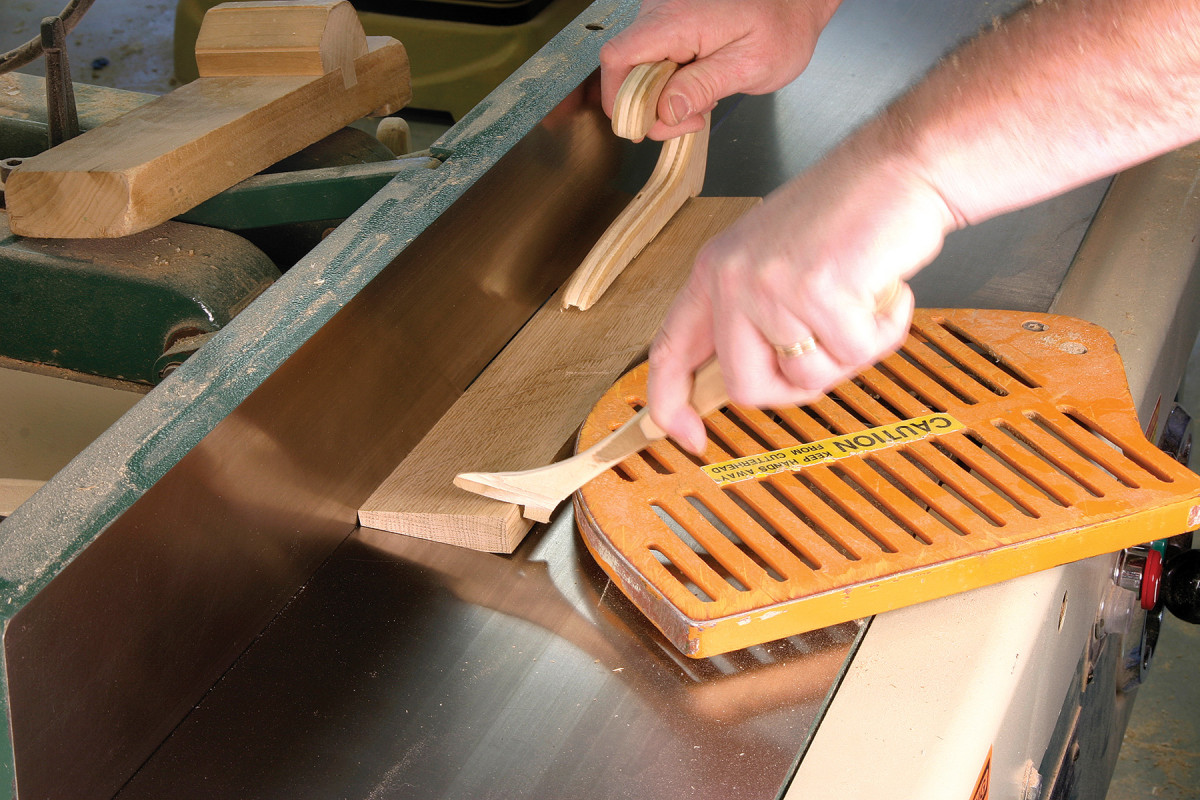
11. While the setup is involved, the ripping of the crown moulding is straightforward. Just make sure to have a push stick handy.
At the miter saw, align the mark with your blade (saw angled to the right) and make the 45° cut. With the top edge up it is easy to match the blade to the layout line. Now to cut your final miter, simply place the end piece at the saw with the top edge pointing down while the face side is out and make the cut. The angle of the saw doesn’t change and the cuts are correct. This is also how I would cut the first mitered corner.
Place the top unit, with the moulding now applied, onto the bookcase top, centered from side to side and flush to the back edge of the top unit. Use pocket screws to attach the frame to the top then set the completed top unit aside.
The Doors are a Snap
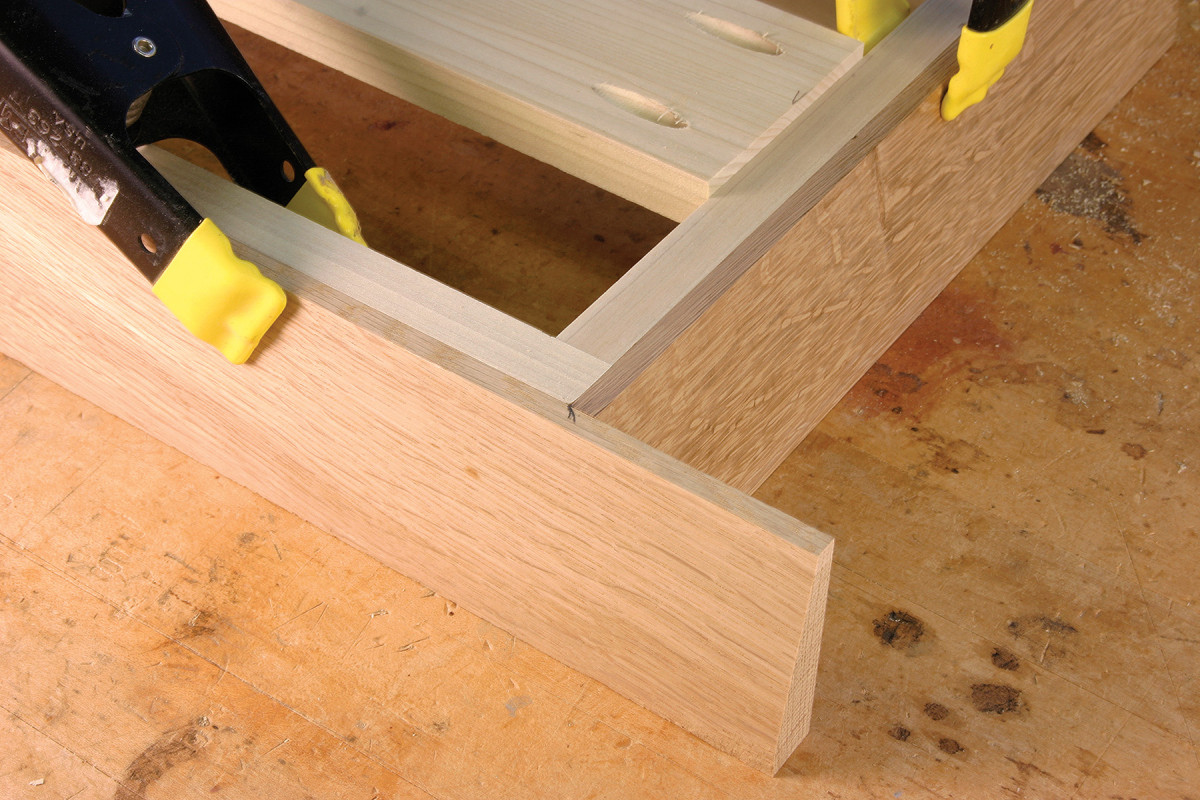
12. The crown moulding is attached to three sides of the top frame. Miter the corners and add a small amount of glue to reinforce the area. Brads will affix the pieces to the frame.
The only easier method that could be used to build doors would be a flat-paneled door and that wouldn’t give us the glass panels that we need for these cases. The secret for these doors is accurate cutting of the pieces.
Rip the material to the required width then set stops at the saw to allow for accurate cutting of the required lengths. If the pieces are all cut to the same sizes (two matching sets of the rails and stiles per door) two things will happen—one, the doors will be square when assembled and two, the assembled doors will correctly fit the openings of the boxes.
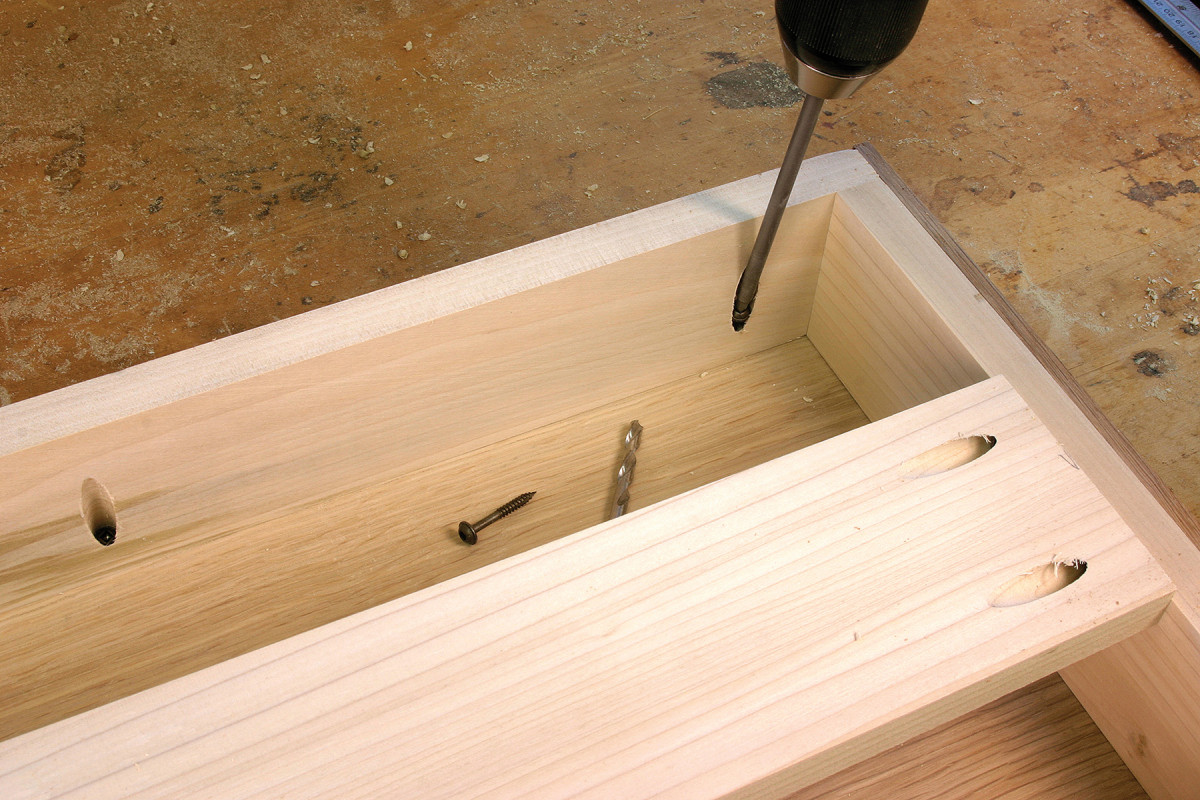
13. Complete the work on the top unit by attaching the moulded frame to the case top. Pocket screws are quick and easy.
Cut the stiles to be 3/16” less than the opening of the box and the rails to be 41/8” less than the total width of that opening. This will build in the appropriate reveal around the doors.
These doors are also assembled with pocket screws placed in the rails, and the location of the holes is important. If the hole is too close to the outside of the rail, as you drive the screws there is potential to crack the end of the stiles. If the hole is set too near the interior of the rails, as you rabbet for the glass, you have the possibility of cutting into the screw area. The best location is at 5/8” from both edges.
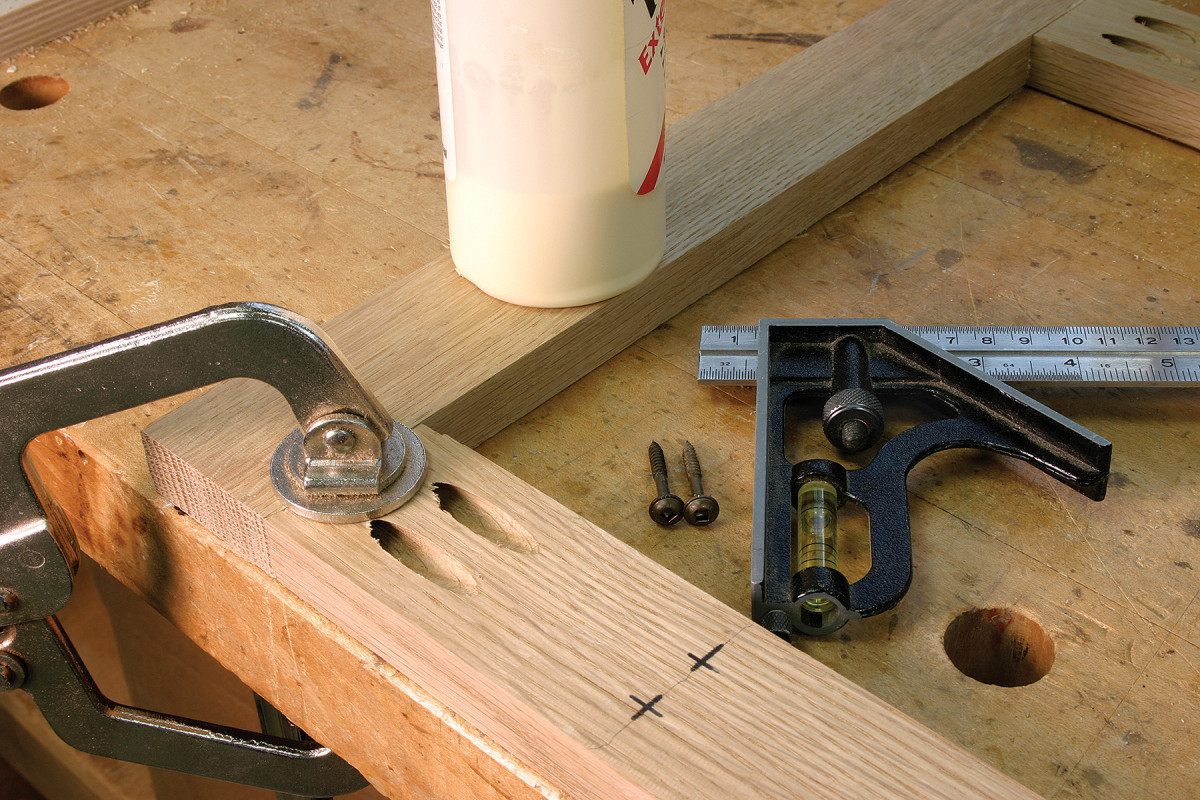
14. Positioning the pocket-screw holes in the door rails is important. Too close to either edge can cause problems. Don’t forget to add glue to the joint.
With the pocket-screw holes cut you can now assemble the doors. Place a clamp over the intersection of the two pieces, a rail and a stile, and drive the screws. Then, work the four corners of each door in the same manner.
Rabbeting the doors for the glass and glass-retainer strips is another router operation. Install a rabbeting bit, set for a 3/8” rabbet, and cut the interior of the frame. It is necessary to position the door hanging over the edge of your table or bench so the bearing screw does not rub the bench.
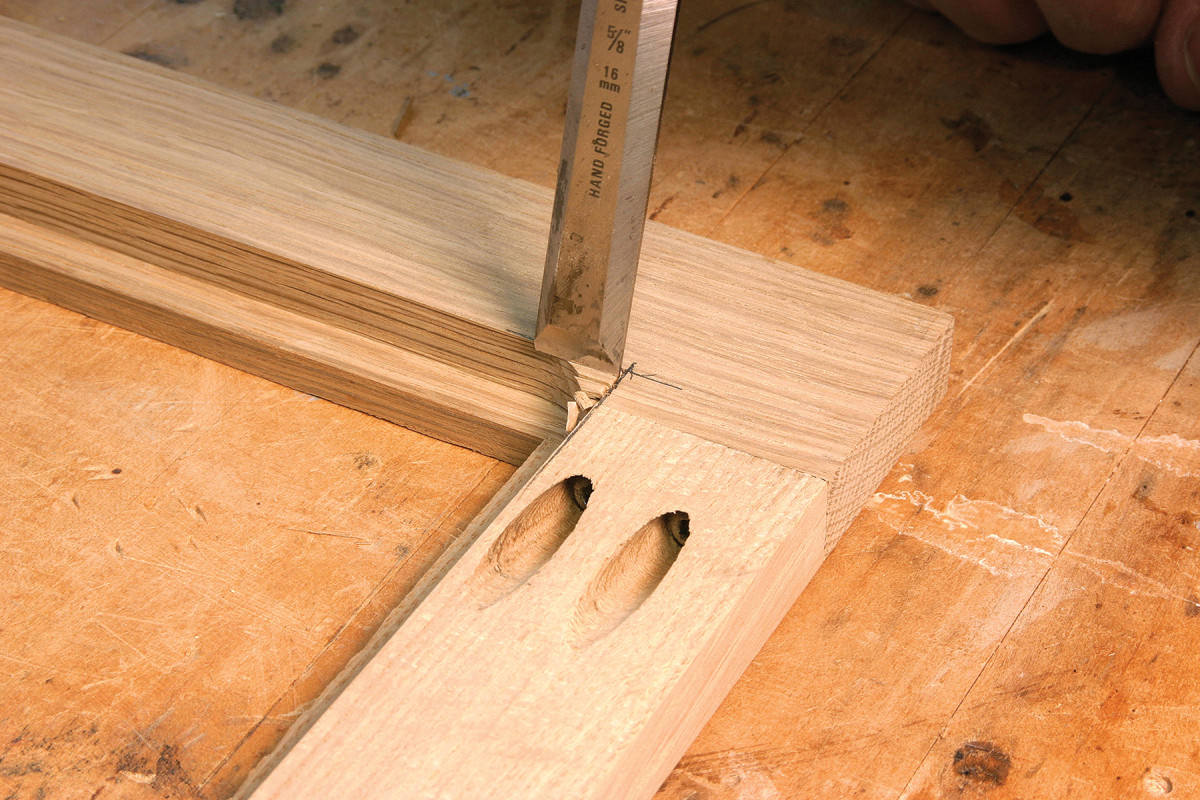
15. Squaring the corners left rounded from the router bit is a job for the chisel. It works best to begin with a cut across the end grain and to then take small cuts with the grain, removing the waste.
If you try to make the entire cut by running the router in the standard manner, into the bit rotation, you’re likely to have areas, especially in quartersawn white oak, that will splinter and tear out. To remedy this you must climb cut during a portion of this process.
Start by climb cutting the first 1/8” of the rabbet then reverse the routing procedure and complete the rabbet. By having a small shelf of routed area from climb cutting, the removal of the balance of the waste material will shear off at that point and prevent most tear-out.
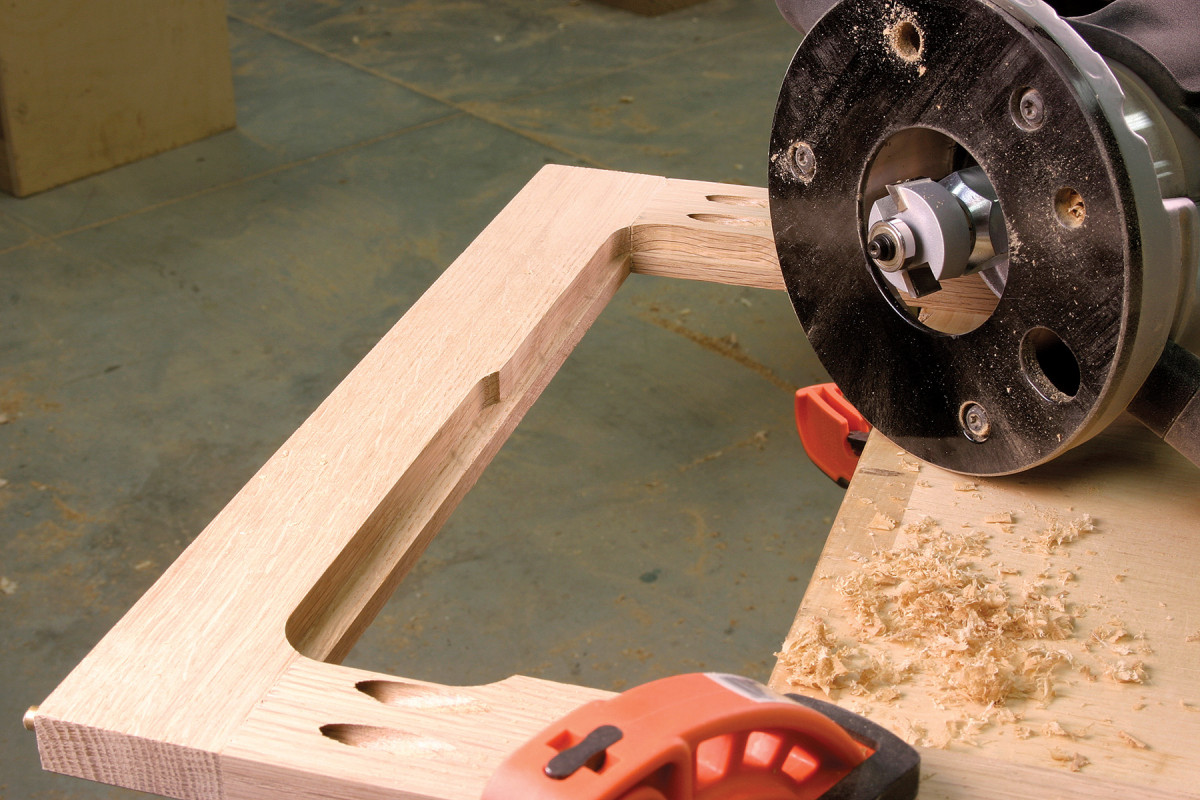
16. The 3/8″ x 1/2″ rabbet for the glass and the retainer strips requires that you climb cut a portion to eliminate any tear-out. Adding a small bevel to the edges of the piece will help the joints between the separate units. The edge work also allows the doors to flip up and slide back into the case without binding.
To complete the rabbet you’ll need to square the rounded corners left from the router bit. Use a straightedge to continue the lines to reveal the exact corner and use a sharp chisel to bring the rounded corners to square. Clean the corners until you’re level with the bottom of the rabbet.
Before moving forward now is the time to create the small bevel on the edges of the doors as well as the edges of the boxes themselves. Chuck a chamfer bit in a router and set it to cut 1/8” and run the profile around the doors outside edge and along the top and bottom of the boxes, including both sides and the front.
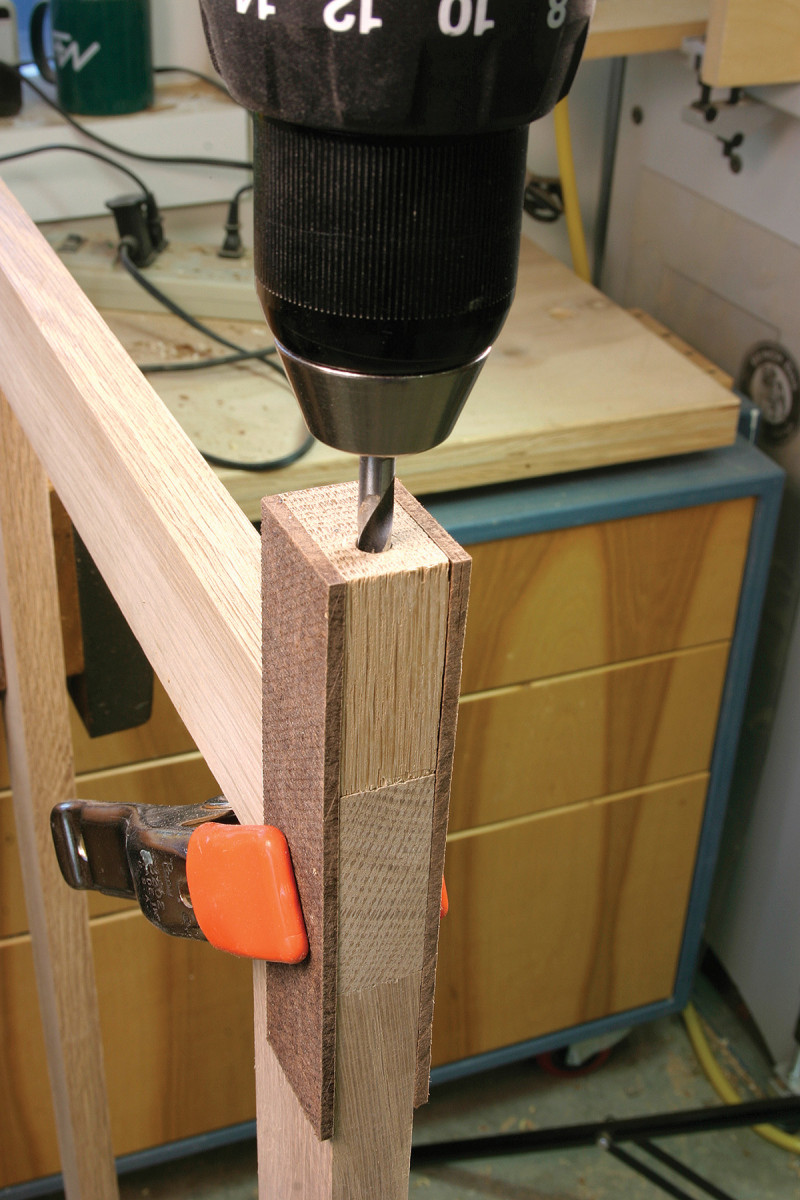
17. Aligning the holes for the doors to pivot becomes easy work with the use of this shop-made jig.
Each door edge, at the top of the door, needs to have a hole drilled to accept the short brass rod (available at any hardware store) on which the door will hang and travel in the groove as it is opened. A shop-made jig is just the trick to complete this step quickly and accurately.
Build the jig using a scrap of the cutoff material from your door pieces. Locate the center of the piece, which will be 3/8” from the edge, and also mark a line that is 3/8” in from the end. At that crossing is where you need to drill the 1/4” hole completely through the block. Use the drill press because you need the hole to be straight.
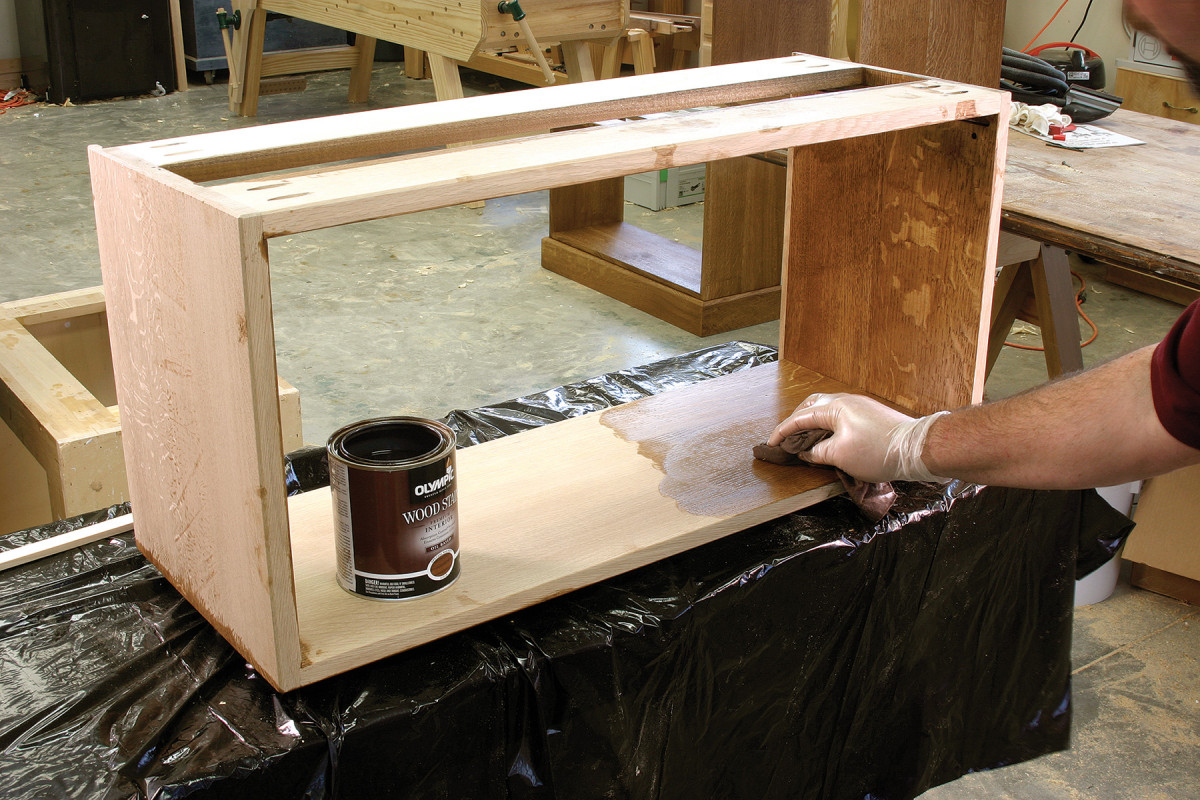
18. The barrister bookcase gets an Arts & Crafts look with the simple finishing method described for this project. It works great for oak—both white and red.
Next, add two pieces of Masonite, or other thin plywood-type material, to both sides of the block. To use the jig, slide it over the long grain of the stile, keeping the 3/8” space toward the top edge of the door. Add a clamp to hold the jig and drill the hole using the jig as a guide. Set the drill bit to cut to a depth of 3/4“.
Drill two holes per door, install a 1″ piece of brass rod using no glue (we need to be able to remove them over the remainder of the project). Once the rods are in place you can test the door to the opening. If you have a problem it will most likely be binding at the top or bottom.
In either case you will need to remove a sliver of material to allow the fit. This can be done at the jointer or with a plane. Both solutions require you to work carefully around the end grain. All that’s left is to cut the plywood pieces that comprise the backs of the individual units and mill a number of pieces to use as the glass retainers from some scrap.
Finish as Easy as the Project
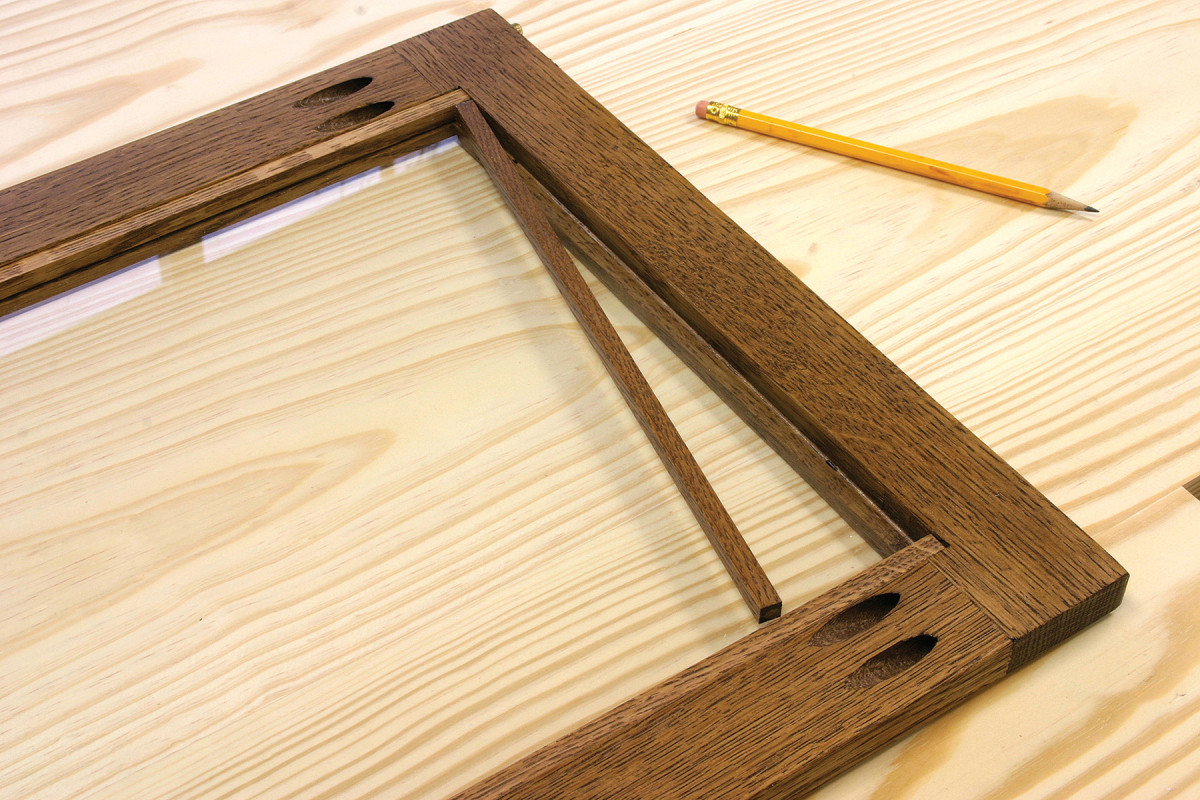
19. With the finish complete, an easy way to install the glass for the doors is with matching retainer strips. They are cut and fit then attached with a 23-gauge pinner.
This finish technique was developed by former Popular Woodworking Senior Editor Robert W. Lang. If this method had been around years ago when I was working with oak, I would have built many more projects from this hardwood. You will not find an easier finish anywhere that I know of.
To begin, don’t waste a huge amount of time sanding. I know you like the sound of that! Bring the piece to #120 grit with the random-orbit sander and finish sand by hand using #150 grit sandpaper. Done! Now you are ready to stain the bookcase.
The staining process continues in the easy category. Rag on a coat of Olympic oil-based “Special Walnut” stain. Apply an even coat and allow it to sit for 15 minutes before wiping any excess away. That coat needs to dry for 24 hours before moving on.
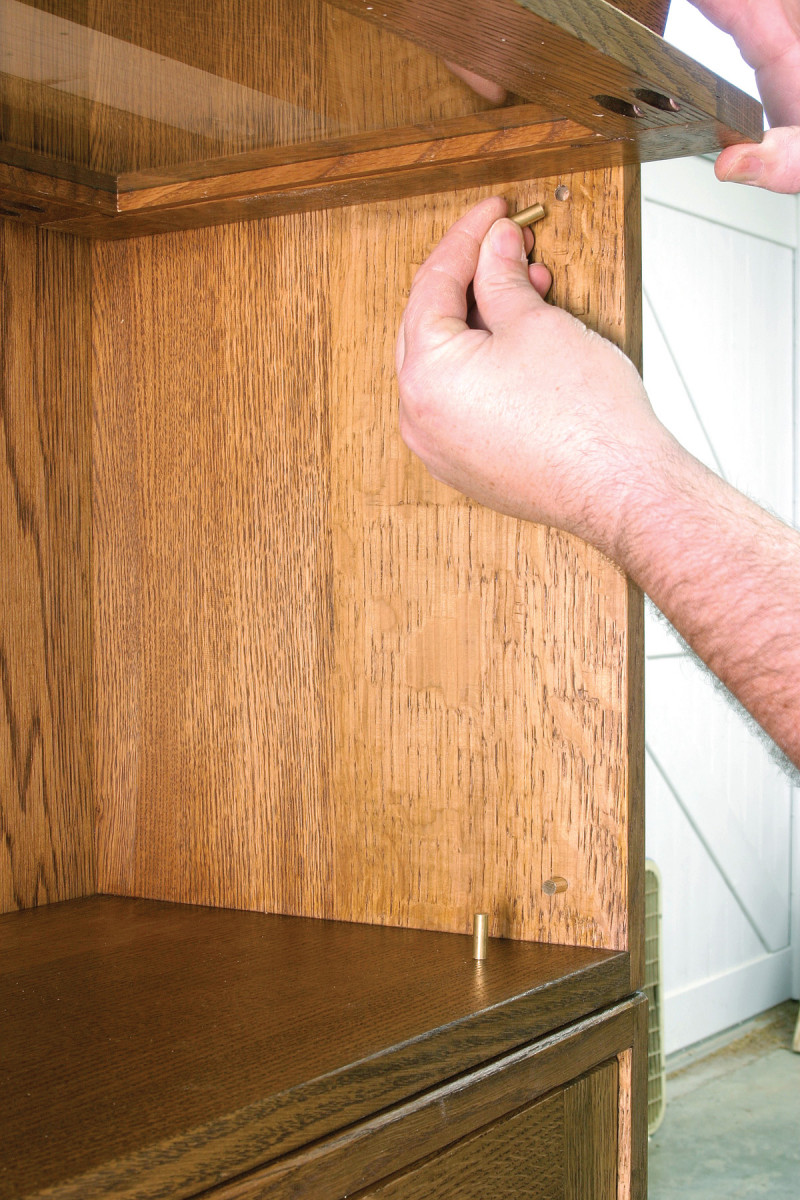
20. No glue is used to hold the brass rods in place. They can be removed if the door should ever need to be taken out of the bookcase.
Next up is one coat of Dark Walnut Watco Danish Oil. Apply this in the same fashion as the stain. Rag a coat onto the stained bookcase and allow that to cure for 15 minutes, then wipe away any extra oil with a clean rag. In this process the oil acts as a toner that will even the shading as it adds color to the project. Again, let the oil coat dry for a day.
The rags used in both of the previous steps can become a fire hazard if not disposed of properly. You can lay the rags out on the floor of your shop or put them into a bucket of water. Combustion is a result of these rags thrown into a pile either in the trash can or a corner of the shop. Always dispose of rags properly.
The final step in the finishing process is to apply a coat of amber shellac. Can you guess how this is applied? You bet: Rag it on. Keep a wet edge on the wide-open areas and on any other areas simply coat them. That’s it. Once the shellac is dry (the next day) add a coat of paste wax after knocking down any nibs with a non-woven abrasive pad.
The Finishing Touch
Attach the plywood backboards to the back of the units with screws after the finish is complete. All that is needed is to run four screws, one at each corner, through the pieces
and into the unit bottom and the rear rail of the unit top. Use a countersink and wood screws for a professional look.
Installing the glass and knobs will complete the bookcases. Have 1/8” glass cut to fit the openings of the doors and fit a glass-retainer strip around the inside of the rabbet holding the glass in place.
The knobs are like the rest of the project; simple and elegant. What would finish this project better than a simple brass knob? Find the location and drill a pilot hole to make installing the knobs a snap. A bit of wax on the threads will ensure easy installation.
Sliding the doors into the boxes is the last step before filling the bookcase with your books. Slide the door into the case on a slight angle to the front, lift the brass rod on the side toward the rear of the case into the groove and position the other rod to move into the groove as you bring the door square to the front.
Lift the door so it is perpendicular to the case and slide it to the rear of the case. Holding the door up to the top of the unit, install 3/4“-long brass rods into the remaining holes. Your barrister bookcase is ready to use.
The great thing about this barrister bookcase design is that as your collection grows, and you know it will, so can your bookcases. You can add to the existing stack or start another bookcase. They are easy to build and adding to the stack is something you will enjoy.
Here are some supplies and tools we find essential in our everyday work around the shop. We may receive a commission from sales referred by our links; however, we have carefully selected these products for their usefulness and quality.







